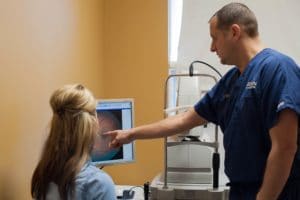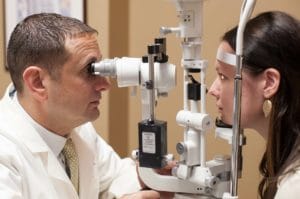Eye Exams
What to Expect
A complete or comprehensive eye exam involves a thorough, detailed examination of your eyes and vision. The doctor will ask you about your medical history, family’s medical history, medications, your overall health and if you are experiencing any eye or vision problems. A number of tests will be performed to assess your overall eye health.
- Visual Acuity Test: This test measures how clearly you see. You will be asked to identify different letters of the alphabet printed on a chart or a screen positioned some distance away. The lines of type get smaller as you move down the chart. Each eye is tested separately.
- Refraction Test: Refraction is how you see things around you. When there is an imperfection in the refraction of your eye, you have “refractive error.” Having refractive error may mean you need some form of correction, such as glasses, contact lenses or refractive surgery, to see as clearly as possible.
Visual Field Test: Your visual field is the full extent of what you can see to the sides without moving your eyes. The visual field test determines whether you have difficulty seeing in any areas of your overall field of vision.
- Slit-Lamp Exam: A slit lamp is a microscope that magnifies and illuminates the front of your eye with an intense line of light. Dr. Adelson uses this light to examine the eyelids, lashes, cornea, iris, lens and fluid chamber between your cornea and iris. When examining your cornea, he may use a dye called fluorescein to color the film of tears over your eye and see any damaged cells on the front of your eye. Your tears wash the dye from the surface of your eye almost immediately.
- Retinal Exam: This allows the doctor to evaluate the back of your eye, including your retina, optic disk and the underlying layer of blood vessel. Sometimes your pupils will need to be dilated with eyedrops that keep the pupil from getting smaller when light is shined into the eye. The retinal examination takes less than 10 minutes, but it may take several hours for the effects of the dilating drops to wear off. Your vision will likely be blurry, and you may have trouble focusing on near objects. If light bothers you, you may need to wear sunglasses for a short time. You may be uncomfortable driving with dilated pupils, so make sure you have transportation after your exam. Depending on what you need to see at work, you might need to wear reading glasses or remove glasses that correct for nearsightedness until the effects of the eyedrops wear off.
Other parts of the exam include tests to:
- See if you have proper three-dimensional (3D) vision.
- Check your side (peripheral) vision.
- Check for color vision.
- Check the eye muscles by asking you to look in different directions at a penlight or other small object.
- Glaucoma screening – using a tonometer, he will test the fluid pressure inside your eyes.
At the end of your eye exam, your doctor will be able to provide a detailed visual assessment along with any preventative measures you need to be aware of to protect your eyesight.
How To Prepare
Call us at 248-449-9292 to make an appointment for a complete eye exam. Avoid eye strain on the day of the test. You may need someone to drive you home if eye drops are used to dilate your pupils. The tests cause no pain or discomfort.
When to Get An Eye Exam
Between ages 20 and 39:
- A complete eye exam should be done every 5 years
- Adults who wear contact lenses need yearly eye exams
- Certain eye symptoms or disorders will require more frequent exams
Adults over age 40 who have no risk factors or ongoing eye conditions should be screened:
- Every 2 to 4 years for adults ages 40 – 54
- Every 1 to 3 years for adults ages 55 – 64
- Every 1 to 2 years for adults age 65 and older
Depending on your risk factors for eye diseases and your current symptoms or illnesses, your doctor may recommend that you have exams more often.


 Visual Field Test: Your visual field is the full extent of what you can see to the sides without moving your eyes. The visual field test determines whether you have difficulty seeing in any areas of your overall field of vision.
Visual Field Test: Your visual field is the full extent of what you can see to the sides without moving your eyes. The visual field test determines whether you have difficulty seeing in any areas of your overall field of vision.